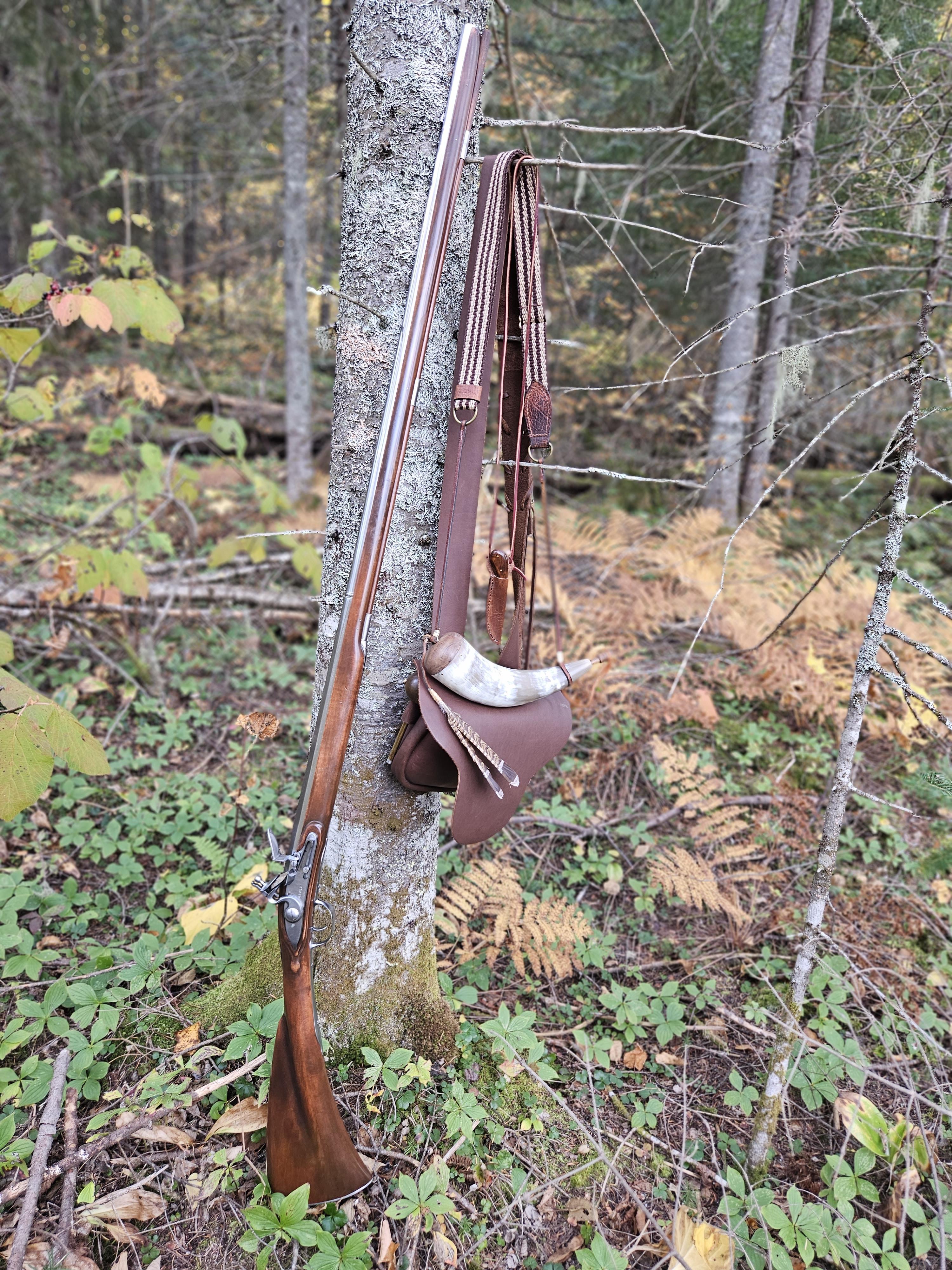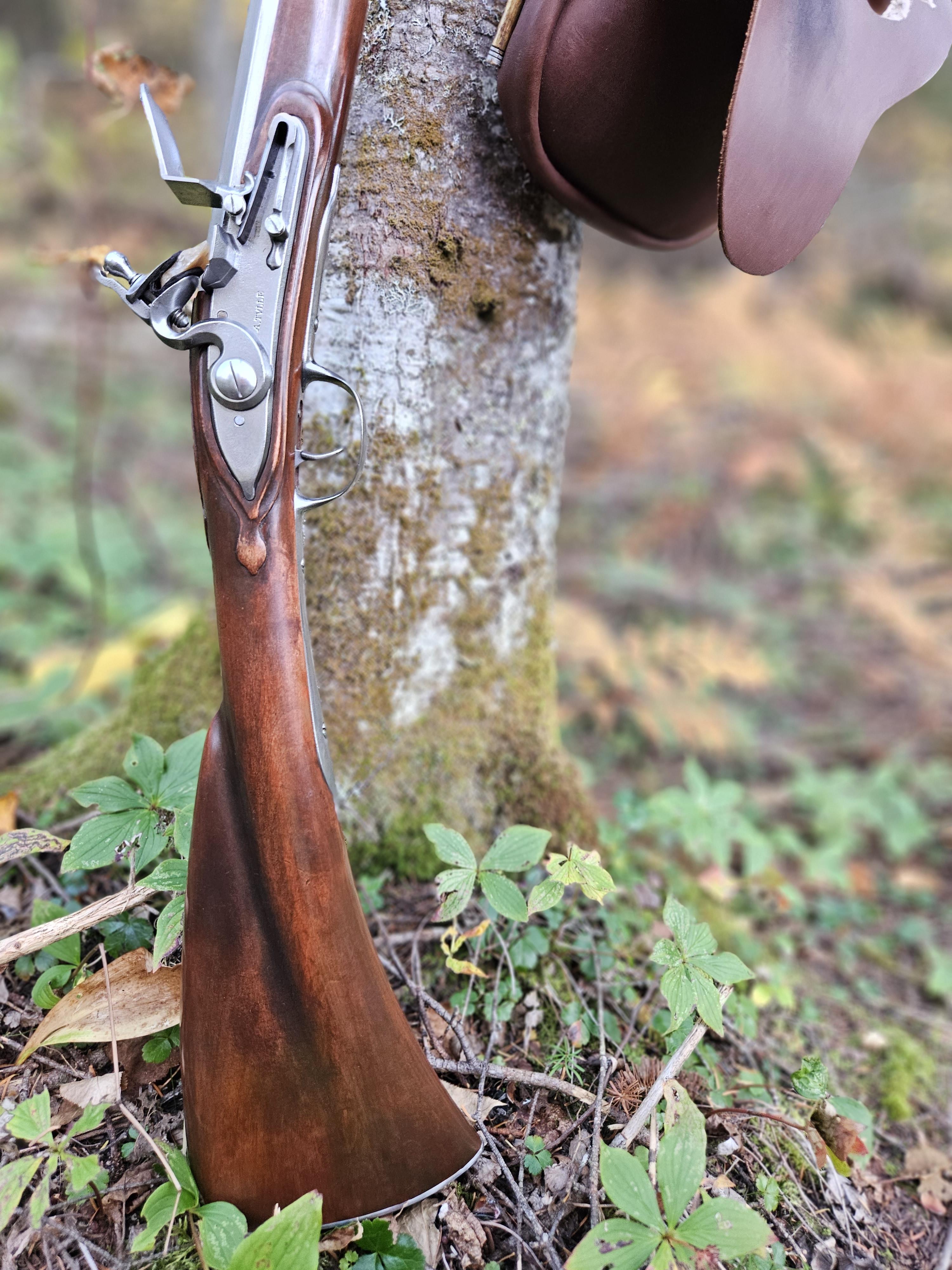Comfortably_Numb
The Evil Mike Brooks
Fusil means gun that's all. Words mean things.

Well mostly they do, but sometimes they get twisted and even the word police screw up, the proper English for the word is Fusee, in French it's Fusil, the word is a corruption of the Italian word Fucile, which doesn't mean "gun", the word (Fusil/Fusee/ or Fucile actually means Flint.Fusil means gun that's all. Words mean things.
Actually, for the best accuracy and best hunting velocity in a smoothbore you have to maintain a minimum load pressure if you expect to have consistency in your loads.I don’t plan on doing any bare ball loads which usually call for high powder charges
" usually it's blamed on the gun or the shape of the stock, but it's not usually the gun's fault."In my experience, "face slapping" "cheek bruising" no matter what it's called by individual shooters is a problem for many shooters, usually it's blamed on the gun or the shape of the stock, but it's not usually the gun's fault.
There are several reasons why a gun's stock can hurt some ones face when it's fired from a natural shooting position, mostly it seems to happen when shooting off hand (standing with gun mounted to the shoulder and supported by the week or off hand.
Yes, loads that are too heavy causing violent recoil is one of the causes, another is a gun that doesn't fit the shooter or that doesn't point naturally or feel comfortable in the shooters hands.
However, I've found that most of those problems are shooter error, not having a proper cheek weld on the stock and or holding the gun too loosely will sometimes raise a welt that usually doesn't become noticeable until it's too late.
We are discussing smoothbore fowlers in particular, and they can be troublesome to learn to shoot well, for one thing most don't have rear sights, usually the only sight is a brass or ivory bead or a low blade front sight close to the end of the muzzle, so the shooters eyes become the rear sight.
I've seen some folks adjust the tang screw so that it sticks up a bit from the barrels plane and the notch in the top of the screw is aligned with the barrel, but in most competitive shoots it's considered cheating.
I've found that with my smoothbore Fusils and Fowlers if I hod the gun firmly and set my face down on the stock so that my dominant eye is looking just along the top of the barrel and I hold my front sight on the center of my target it will shoot exactly where I'm looking (at 25 yds.) every time, and because my cheek and the gun stock are one through the shot I don't feel a thing, but hold the gun too loosely or have your face down on the stock too loosely and you will feel the recoil.
Well, since you asked, while it is possible that a gun could be built with some sort of imperfection, I'm reminded of a used Skeet gun that I purchased once, it was so beautiful that I jumped on it before examining it a closely as I should have." usually it's blamed on the gun or the shape of the stock, but it's not usually the gun's fault."
" another is a gun that doesn't fit the shooter or that doesn't point naturally or feel comfortable in the shooters hands."
So which is it, is it the gun or not?
I did not think it was aggressive at all.Well, since you asked, while it is possible that a gun could be built with some sort of imperfection, I'm reminded of a used Skeet gun that I purchased once, it was so beautiful that I jumped on it before examining it a closely as I should have.
My first time out on the Skeet field with it told me why the price was so "right", the stock had a cast off that made it very uncomfortable for me to shoot well.
In that case some could say I didn't shoot it well because the stock was screwed up, but realistically the fault was mine for not paying closer attention to what I was buying.
I am curious however why you would pose your question in such an aggressive manner, did I say something that disturbed you ?
Miroku is well known for making fine guns of all types, it's also been noted that when Miroku copies a period piece they copy it in every detail, in one post on this forum a member stated that he purchased a Miroku reproduction of a period muzzle loader that had a flat spot on the trigger guard that looked odd, a call to Miroku informed him that the specimen that they were sent to reproduce was from a collection and it had a flat spot on the rigger guard.I love mine, it is a Danny Caywood gun and shoots great. My worst ever fitting gun was a Miroku Brown Bess that gave me a cheek bruise every time I shot it, I would not give a nickel for another one.
I guess we can agree on your points, we just see it differently, I my case I sold the skeet gun to a guy who it fit much better, for me to get a replacement stock made would have cost about a thousand plus dollars and it it would have taken away from the gun original value.I did not think it was aggressive at all.
It appeared to me that your two statements were totally opposite, one said "not the guns fault' the other said "doesn't fit the shooter"
The fact of the matter is, just like the skeet gun that has cast off, the gun did not fit you, it may have been a mistake to buy it but a new stock could be made for it which would mean the gun could be fixed. If something can be fixed is it at fault?
Other cases of stocks to long or short, combs to high or low or a myriad of other things CAN be laid upon the gun not being right for the shooter. All of these things to me can be the guns fault when the target is missed or a bruised cheek results from a days shooting.

I loved my Miroku Brown Bess. Made it from a "returned" kit at Log Cabin Sport Shop . $150 was the cost. Shot it for years during the Bicentennial. I sold it after I acquired a custom long land pattern by Jim Everett. Wish I had it back.I love mine, it is a Danny Caywood gun and shoots great. My worst ever fitting gun was a Miroku Brown Bess that gave me a cheek bruise every time I shot it, I would not give a nickel for another one.
I love the graceful looks of the French fusils. I have a model 1728 that I modified from a Japanese 1763/66 musket. I like the '28s stock better.Here are a couple of nice Fucil de Chasse by Pecatonica.
Yep , your right. Everyone should shoot 100 gr. of 3F or more in their smoothbores ....Good idea ....Actually, for the best accuracy and best hunting velocity in a smoothbore you have to maintain a minimum load pressure if you expect to have consistency in your loads.
I have used small powder charges for small game hunting or when I'm woods bumming and just stump shooting and they are ok when it doesn't matter much.
But when I'm hunting for real or in a shooting match I use a standard moderate velocity load and load with card and cushion wads all the time and my loads are always right on the money.
I'm shooting one of two Fusil de chasse smoothbores when I shoot, both are pretty much identical and use the same loads, for my shot loads I use 100 gr. of 2-F Goex under 2 ounces of shot (normally #5 shot), for patched round ball I use 80 gr. of 3-F under a .600 cast or swagged lead round ball wrapped in a 1-1/2"x 1-1/2" white cotton cleaning patch, I use an over powder card then a lubed fiber cushion wad, and lastly the patched round ball.
For my shot loads I found that if I use a smaller powder load and or a 1-1/8 oz. of shot it would blow my pattern, but using the 100 gr. 2-F powder and 2-ounce #5 shot loads I get a great pattern out to 40+ yds. our of my cyl, bore barrels.
And for round ball shooting, the .600~20 ga. round balls are heavy, and without the spin of rifling to give the ball flight stability it drops pretty fast, so you have to load moderately heavy to get the ball to the target.
Allot of new smoothbore shooters complain about their guns shooting low, that they have to cover the target with their muzzles in order to get them to shoot higher, when asked most will say they are using 40, 50, and 60 gr. loads of 2-F powder, and that's the cause of their problem, it's not the gun that's shooting low, it the powder charge that's too week to keep the ball in the air long enough to reach the target.
Lets don't forget either, that your shooting a smoothbore 20 ga. shotgun with no rifling or tightfitting patch/ball combination, so recoil is going to be allot milder than if you were shooting a big bore rifle, so don't be afraid to experiment with powder loads.
You did a fine job! I’ve been eyeing the pecatonia kits but drilling the barrel pins makes me too uncomfortable. I’ve done it before on a traditions gun and did alright even though I was using a craftsman battery drill. I’d rather not do it myself unless I acquire a drill press. And I’ve never used chisels so fully inletting the lock worries me, I know it’s almost fully inlet but idk I’m just worried im going to mess it up.Here are a couple of nice Fusil de Chasse I built from Pecatonica.
I like 3-F in most of my rifles and revolvers, and I like it in moderation in my Fusils, but I don't think I'd go up to 100 gr. of 3-f in my smoothbore.Yep , your right. Everyone should shoot 100 gr. of 3F or more in their smoothbores ....Good idea ....

